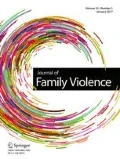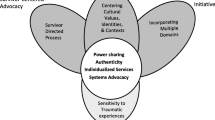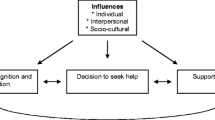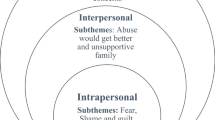Abstract
Despite a population of over two million Vietnamese people in the United States, very few domestic violence shelters employ Vietnamese-speaking staff or provide culturally responsive services. Research on the needs of Vietnamese intimate partner violence (IPV) survivors is also sparse, and very few studies have asked Vietnamese IPV survivors themselves about their service recommendations. To fill this gap in the literature, the current study conducted qualitative interviews and focus groups with 20 Vietnamese IPV survivors and 13 service providers about IPV services for Vietnamese survivors living in the United States. Analytic Induction was used to identify recommendations for culturally responsive services at the practitioner, intervention, and institutional levels. Participant recommendations were primarily at the intervention and institutional levels. At the institutional level, participants recommended more community outreach and education. At the intervention level, participants recommended more comprehensive and long-term services, more accessible services and locations, and incorporating cultural values and norms into services. At the practitioner level, participants recommended hiring bilingual/bicultural staff and providing culturally responsive and trauma-informed training. Much of the cultural competency literature focuses on practitioner skills and knowledge, but findings from the current study suggest that changes at the intervention and institutional level are just as important. Such changes include the development of non-Western service models, relationship-based methods of community engagement, and long-term services to meet survivors’ needs.
Similar content being viewed by others
References
Aday, L., & Andersen, R. (1974). A framework for the study of access to medical care. Health Services Research, 9(3), 208–220.
Allen, D. (2008). Cultural competency training in a global society. New Yorks: Springer.
American Psychiatric Association. (2020). Best practice highlights for treating diverse patient populations: A guide to help assessment and treatment of patients from diverse populations. American Psychiatric Association.
American Psychological Association. (2017). Multicultural guidelines: An ecological approach to context, identity, and Intersectionality. American Psychological Association http://www.apa.org/about/policy/multicultural-guidelines.pdf
Anderson, L. M., Scrimshaw, S. C., Fullilove, M. T., Fielding, J. E., & Normand, J. (2003). Culturally competent healthcare systems: A systematic review. American Journal of Preventive Medicine, 24(3 Suppl), 68–79. https://doi.org/10.1016/S0749-3797(02)00657-8.
Appel, H., Huang, B., Ai, A., & Lin, C. (2011). Physical, behavioral, and mental health issues in Asian American women: Results from the National Latino Asian American Study. Journal of Women’s Health, 20(11), 1703–1711. https://doi.org/10.1089/jwh.2010.2726.
Bauer, H., Rodriguez, M., Quiroga, S., & Flores-Ortiz, Y. (2000). Barriers to health care for abused Latina and Asian immigrant women. Journal of Health Care for the Poor and Underserved, 11, 33–44. https://doi.org/10.1353/hpu.2010.0590.
Beach, M. C., Price, E. G., Gary, T. L., Robinson, K. A., Gozu, A., Palacio, A., et al. (2005). Cultural competence: A systematic review of health care provider educational interventions. Medical Care, 43(4), 356–373. https://doi.org/10.1097/01.mlr.0000156861.58905.96.
Benish, S. G., Quintana, S., & Wampold, B. E. (2011). Culturally adapted psychotherapy and the legitimacy of myth: A direct-comparison meta-analysis. Journal of Counseling Psychology, 58, 279–289. https://doi.org/10.1037/a0023626.
Benuto, L. T., Newlands, R., Singer, J., Casas, J., & Cummings, C. (2020). Culturally sensitive clinical practices: A mixed methods study. Psychological Services. Advance online publication. https://doi.org/10.1037/ser0000493.
Benuto, L. T., Casas, J., & O’Donohue, W. T. (2018). Training culturally competent psychologists: A systematic review of the training outcome literature. Training and Education in Professional Psychology, 12(3), 125–134. https://doi.org/10.1037/tep0000190.
Betancourt, J. R. (2006). Cultural competence and medical education: Many names, many perspectives, one goal. Academic Medicine, 81(6), 499–501. https://doi.org/10.1097/01.acm.0000225211.77088.cb.
Betancourt, J. R., Green, A. R., Carrillo, J. E., & Ananeh-Firempong, O. (2003). Defining cultural competence: A practical framework for addressing racial/ethnic disparities in health and health care. Public Health Reports, 118(4), 293–302. https://doi.org/10.1016/s0033-3549(04)50253-4.
Bird, J., Otero-Sabogal, R., Ha, N., & McPhee, S. (1996). Tailoring lay health worker interventions for diverse cultures: Lessons learned from Vietnamese and Latina communities. Health Education Quarterly, 23, 105–122. https://doi.org/10.1177/109019819602301S09.
Brach, C., & Fraserirector, I. (2000). Can cultural competency reduce racial and ethnic health disparities? A review and conceptual model. Medical Care Research Review, 57(Suppl 1), 181–217. https://doi.org/10.1177/1077558700057001S09.
Bui, H. (2003). Help-seeking behavior among abused immigrant women: A case of Vietnamese American women. Violence Against Women, 9(2), 207–239. https://doi.org/10.1177/1077801202239006.
Bui, H. N., & Morash, M. (1999). Domestic violence in the Vietnamese immigrant community: An exploratory study. Violence Against Women, 5(7), 769–795. https://doi.org/10.1177/10778019922181473.
Campbell, R., Sefl, T., Barnes, H., Ahrens, C., Wasco, S., & Zaragoza-Diesfeld, Y. (1999). Community services for rape survivors: Enhancing psychological well-being or increasing trauma? Journal of Consulting and Clinical Psychology, 67(6), 847–858.
Chu, J., Leino, A., Pflum, S., & Sue, S. (2016). A model for the theoretical basis of cultural competency to guide psychotherapy. Professional Psychology: Research and Practice, 47, 18–29. https://doi.org/10.1037/pro0000055.
Cross, T., Bazron, B., Dennis, K., & Isaacs, M. (1989). Towards a culturally competent system of care. Washington, DC: National Technical Assistance Center for Children’s Mental Health, Georgetown University Child Development Center.
Do, K., Weiss, B., & Pollack, A. (2013). Cultural beliefs, intimate partner violence, and mental health functioning among Vietnamese women. International Perspectives in Psychology: Research, Practice, Consultation, 2(3), 149–163. https://doi.org/10.1037/ipp0000004.
Eby, K. (2004). Exploring the stressors of low-income women with abusive partners: Understanding their needs and developing effective community responses. Journal of Family Violence, 19(4), 221–232. https://doi.org/10.1023/B:JOFV.0000032632.59865.8e.
Elder, J. P., Ayala, G. X., Parra-Medina, D., & Talavera, G. A. (2009). Health communication in the Latino community: Issues and approaches. Annual Review of Public Health, 30(1), 227–251. https://doi.org/10.1146/annurev.publhealth.031308.100300.
Fancher, T. L., Ton, H., Le Meyer, O., Ho, T., & Paterniti, D. A. (2010). Discussing depression with Vietnamese American patients. Journal of Immigrant and Minority Health, 12(2), 263–266. https://doi.org/10.1007/s10903-009-9234-y.
Johnson, Y. M., & Munch, S. (2009). Fundamental contradictions in cultural competence. Social Work, 54(3), 220–231. https://doi.org/10.1093/sw/54.3.220.
Kim, J. E., & Zane, N. (2016). Help-seeking intentions among Asian American and white American students in psychological distress: Application of the health belief model. Cultural Diversity and Ethnic Minority Psychology, 22(3), 311–321. https://doi.org/10.1037/cdp0000056.
Kim-Goh, M., & Baello, J. (2008). Attitudes toward domestic violence in Korean and Vietnamese immigrant communities: Implications for human services. Journal of Family Violence, 23(7), 647–654. https://doi.org/10.1007/s10896-008-9187-2.
Kirmayer, L. J. (2012). Rethinking cultural competence. Transcultural Psychiatry, 49(2), 149–164. https://doi.org/10.1177/1363461512444673.
Greeson, M., & Campbell, R. (2011). Rape survivors’ agency within the legal and medical systems. Psychology of Women Quarterly, 35(4), 582–595. https://doi.org/10.1177/0361684311418078.
Griner, D., & Smith, T. B. (2006). Culturally adapted mental health intervention: A meta-analytic review. Psychotherapy: Theory, Research, Practice, Training, 43, 531–548. https://doi.org/10.1037/0033-3204.43.4.531.
Hernandez, M., Nesman, T., Mowery, D., Acevedo-Polakovich, I. D., & Callejas, L. M. (2009). Cultural competence: A literature review and conceptual model for mental health services. Psychiatric Services, 60(8), 1046–1050. https://doi.org/10.1176/ps.2009.60.8.1046.
Lee, S., Juon, H., Martinez, G., Hsu, C., Robinson, E., Bawa, J., & Ma, G. (2009). Model minority at risk: Expressed needs of mental health by Asian American young adults. Journal of Community Health, 34(2), 144–152. https://doi.org/10.1007/s10900-008-9137-1.
Leung, P., & Cheung, M. (2008). A prevalence study on partner abuse in six Asian American ethnic groups in the USA. International Social Work, 51(5), 635–649. https://doi.org/10.1177/0020872808093342.
Macy, R., Giattina, M., Sangster, R., Crosby, C., & Montijo, N. (2009). Domestic violence and sexual assault services: Inside the black box. Aggression and Violent Behavior, 14(5), 359–373. https://doi.org/10.1016/j.avb.2009.06.002.
McKernan, H. & Weber, L. (2016). Vietnamese Australians' perceptions of the trustworthiness of police. Australian and New Zealand Journal of Criminology, 49(1), 9–29.
Morash, M., Bui, H., Zhang, Y., & Holtfreter, K. (2007). Risk factors for abusive relationships: A study of Vietnamese American immigrant women. Violence Against Women, 13(7), 653–675. https://doi.org/10.1177/1077801207302044.
Morash, M., Bui, H., Stevens, T., & Zhang, Y. (2008). Getting out of harm’s way: One-year outcomes for abused women in a Vietnamese immigrant enclave. Violence Against Women, 14(12), 1413–1429. https://doi.org/10.1177/1077801208327020.
National Academies of Sciences, Engineering, and Medicine. (2017). Communities in action: Pathways to health equity. Washington, DC: National Academies Press.
National Association of Social Workers (2015). Standards and indicators for cultural competence in social work practice. National Association of Social Workers. https://www.socialworkers.org/LinkClick.aspx?fileticket=PonPTDEBrn4%3D&portalid=0
Nguyen, T. (2004). Vietnamese women and domestic violence: A qualitative examination. The Qualitative Report, 9(3), 435–448.
Nguyen, P., Leung, P., & Cheung, M. (2011). Bridging help-seeking options to Vietnamese Americans with parent-child conflict and depressive symptoms. Children and Youth Services Review, 33(10), 1842–1846. https://doi.org/10.1016/j.childyouth.2011.05.009.
Nguyen, Q., & Anderson, L. (2005). Vietnamese Americans attitudes toward seeking mental health services: Relation to cultural variables. Journal of Community Psychology, 33(2), 213–231. https://doi.org/10.1002/jcop.20039.
Pan, A., Daley, S., Rivera, L. M., Williams, K., Lingle, D., & Reznik, V. (2006). Understanding the role of culture in domestic violence: The ahimsa project for safe families. Journal of Immigrant and Minority Health, 8(1), 35–43. https://doi.org/10.1007/s10903-006-6340-y.
Papps, E., & Ramsden, I. (1996). Cultural safety in nursing: The New Zealand experience. International Journal for Quality in Health Care, 8(5), 491–497. https://doi.org/10.1093/intqhc/8.5.491.
Park, Y. (2005). Culture as deficit: A critical discourse analysis of the concept of culture in contemporary social work discourse. Journal of Sociology & Social Welfare, 32(3), 13–33 https://scholarworks.wmich.edu/jssw/vol32/iss3/3.
Penchansky, R., & Thomas, J. W. (1981). The concept of access: Definition and relationship to consumer satisfaction. Medical Care, 19(2), 127–140. https://doi.org/10.1097/00005650-198102000-00001.
Pokharel, B., Hegadoren, K., & Papathanassoglou (2020). Factors influencing silencing of women who experience intimate partner violence: An integrative review. Aggression and Violent Behavior, 52, https://doi.org/10.1016/j.avb.2020.101422
Rodriguez, M., Sheldon, W., Bauer, H., & Perez-Stable, E. (2001). The factors associated with disclosure of intimate partner abuse to clinicians. The Journal of Family Practice, 50(4), 338–344 https://dx.doi.org/10.5249%2Fjivr.v1i1.15.
Rydstrom, H. (2003). Encountering “hot” anger: Domestic violence in contemporary Vietnam. Violence Against Women, 9(6), 676–697. https://doi.org/10.2307/2087508.
Saurman, E. (2016). Improving access: Modifying Penchansky and Thomas’s theory of access. Journal of Health Services Research & Policy, 21(1), 36–39. https://doi.org/10.1177/1355819615600001.
Schuler, S. R., Lenzi, R., Hoang, T., Vu, S., Yount, K. M., & Trang, Q. T. (2016). Recourse seeking and intervention in the context of intimate partner violence in Vietnam: A qualitative study. Journal of Family Issues, 37(8), 1151–1173. https://doi.org/10.1177/0192513X14539155.
Senturia, K., Sullivan, M., Ciske, S., & Shiu-Thornton, S. (2000). Cultural issues affecting domestic violence service utilization in ethnic and hard to reach populations (report no. 185357). Seattle, WA: Public Health-Seattle & King County. https://www.ncjrs.gov/pdffiles1/nij/grants/185357.pdf
Shiu-Thornton, S., Senturia, K., & Sullivan, M. (2005). “Like a bird in a cage”: Vietnamese women survivors talk about domestic violence. Journal of Interpersonal Violence, 20, 959–976. https://doi.org/10.1177/0886260505277677.
Snowden, L. R., & Cheung, F. K. (1990). Use of inpatient mental health services by members of ethnic minority groups. American Psychologist, 45(3), 347–355. https://doi.org/10.1037/0003-066X.45.3.347.
Stacciarini, J., Rosa, A., Ortiz, M., Munari, D., Uicab, G., & Balam, M. (2012). Promotaras in mental health: A review of English, Spanish, and Portugese literature. Family & Community Health, 35(2), 92–102. https://doi.org/10.1097/FCH.0b013e3182464f65.
Stuart, R. B. (2004). Twelve practical suggestions for achieving multicultural competence. Professional Psychology: Research and Practice, 35, 3–9. https://doi.org/10.1037/07357028.35.1.3.
Substance Abuse and Mental Health Services Administration. (2014). Improving cultural competence. Treatment improvement protocol (TIP) series no. 59. HHS publication no. (SMA) 14–4849. Rockville, MD: Substance Abuse and Mental Health Services Administration.
Sullivan, C., & Virden, T. (2017). An eight state study on the relationships among domestic violence shelter services and residents’ self-efficacy and hopefulness. Journal of Family Violence, 32(8), 741–750. https://doi.org/10.1007/s10896-017-9930-7.
Sue, D. W., & Sue, D. (2016). Counseling the culturally diverse. Hoboken: Wiley.
Sue, S., Fujino, D. C., Hu, L. T., Takeuchi, D. T., & Zane, N. W. (1991). Community mental health services for ethnic minority groups: A test of the cultural responsiveness hypothesis. Journal of Consulting and Clinical Psychology, 59(4), 533–540. https://doi.org/10.1037/0022-006X.59.4.533.
Sue, S., Zane, N., Nagayama Hall, G. C., & Berger, L. K. (2009). The case for cultural competency in psychotherapeutic interventions. Annual Review of Psychology, 60, 525–548. https://doi.org/10.1146/annurev.psych.60.110707.163651.
Taft, A. J., Small, R., & Hoang, K. A. (2008). Intimate partner violence in Vietnam and among Vietnamese diaspora communities in western societies: A comprehensive review. Journal of Family Studies, 14(2–3), 167–182. https://doi.org/10.5172/jfs.327.14.2-3.167.
Tervalon, M., & Murray-Garcia, J. (1998). Cultural humility versus cultural competence: A critical distinction in defining physician training outcomes in multicultural education. Journal of Health Care for the Poor and Underserved, 9(2), 117–125. https://doi.org/10.1353/hpu.2010.0233.
Torres, S., & Vogel, E. (2001). Pre and post-test differences between Vietnamese and Latino residents involved in a community policing experiment: Reducing fear of crime and improving attitudes towards the police. Policing: An International Journal of Police Strategies & Management, 24(1), 40–55. https://doi.org/10.1108/13639510110382250.
Tran, C. (1997). Domestic violence among Vietnamese refugee women: Prevalence, abuse characteristics, psychiatric symptoms, and psychosocial factors (unpublished doctoral dissertation). Boston University. https://psycnet.apa.org/record/1997-95010-222
Tsang, D. C. (1994). Asians are automatically labeled gang members. Los Angeles Times. https://www.latimes.com/archives/la-xpm-1994-12-12-me-7941-story.html
U.S. Census Bureau (2018). 2017 American community survey 1-year estimates. U.S. Census Bureau. https://factfinder.census.gov/faces/tableservices/jsf/pages/productview.xhtml?pid=ACS_17_1YR_S0201&prodType=table
U.S. Department of Health and Human Services. (2013). National standards for culturally and linguistically appropriate services (CLAS) in health and health care. U.S. Department of Health and Human Services. https://thinkculturalhealth.hhs.gov/assets/pdfs/EnhancedNationalCLASStandards.pdf
Vu, H., Schuler, S., Hoang, T., & Quach, T. (2014). Divorce in the context of domestic violence against women in Vietnam. Culture, Health, & Sexuality, 16(6), 634–647. https://doi.org/10.1080/13691058.2014.896948.
Whaley, A. L. (2008). Cultural sensitivity and cultural competence: Toward clarity of definitions in cross-cultural counselling and psychotherapy. Counselling Psychology Quarterly, 21, 215–222. https://doi.org/10.1080/09515070802334781.
Yoshioka, M., Dinoia, J., & Ullah, K. (2001). Attitudes toward marital violence: An examination of four Asian communities. Violence Against Women, 7(8), 900–926. https://doi.org/10.1177/10778010122182820.
Znaniecki, F. (1934). The method of sociology. New York: Farrar and Rinehart.
Author information
Authors and Affiliations
Corresponding author
Additional information
Publisher’s Note
Springer Nature remains neutral with regard to jurisdictional claims in published maps and institutional affiliations.
This project was supported by Award No. 2013-MU-CX-0038, awarded by the National Institute of Justice, Office of Justice Programs, U.S. Department of Justice to Mindy Mechanic, Ph.D. and Courtney Ahrens, Ph.D. The views expressed in this article are those of the authors and do not reflect the positions or policies of California State University at Long Beach, California State University at Fullerton, or the National Institute of Justice.
Rights and permissions
About this article
Cite this article
Ahrens, C., Nguyen, P., Phan, S. et al. Creating Culturally Responsive Services for Vietnamese-Heritage Survivors of Intimate Partner Violence. J Fam Viol 37, 207–219 (2022). https://doi.org/10.1007/s10896-021-00261-w
Accepted:
Published:
Issue Date:
DOI: https://doi.org/10.1007/s10896-021-00261-w




